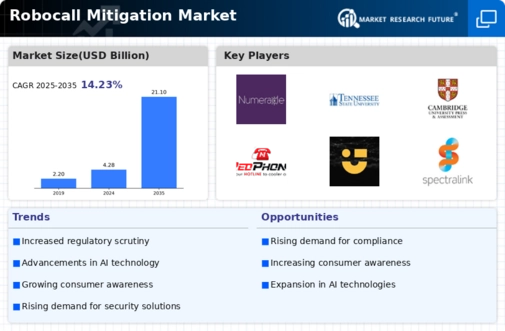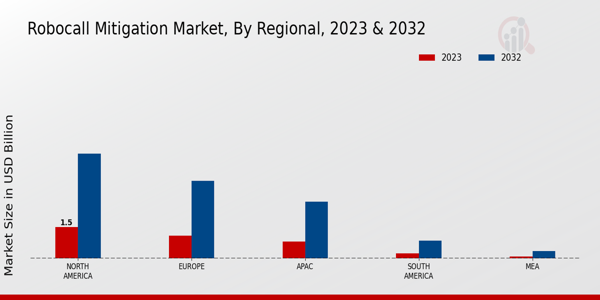Rise of Mobile Communication
The proliferation of mobile communication devices contributes significantly to the expansion of the Global Robocall Mitigation Market Industry. As mobile phone usage continues to rise globally, so does the incidence of robocalls targeting mobile users. This trend compels telecom operators and service providers to implement effective mitigation strategies to protect their customers. The increasing reliance on mobile communication for both personal and professional interactions underscores the urgency for robust solutions. As a result, the market is poised for growth, driven by the need to safeguard mobile users from the adverse effects of robocalls.
Increasing Regulatory Pressure
The Global Robocall Mitigation Market Industry experiences heightened regulatory scrutiny as governments worldwide implement stricter laws to combat unsolicited calls. In the United States, the Federal Communications Commission (FCC) has mandated that telecom providers adopt call authentication protocols to reduce robocalls. This regulatory environment fosters innovation and investment in mitigation technologies, as companies seek to comply with these regulations. As a result, the market is projected to grow from 4.28 USD Billion in 2024 to 21.1 USD Billion by 2035, reflecting a robust CAGR of 15.62% from 2025 to 2035.
Consumer Demand for Enhanced Privacy
Growing consumer awareness regarding privacy and data protection fuels demand within the Global Robocall Mitigation Market Industry. Individuals are increasingly concerned about unsolicited calls that invade their privacy and potentially lead to scams. This heightened awareness drives consumers to seek solutions that provide better control over their communication channels. Consequently, businesses are compelled to invest in robust robocall mitigation technologies to meet these consumer expectations. The market's growth trajectory appears promising, as companies that prioritize consumer privacy are likely to gain a competitive edge in this evolving landscape.
Integration of AI and Machine Learning
The integration of artificial intelligence and machine learning technologies into robocall mitigation strategies represents a transformative driver for the Global Robocall Mitigation Market Industry. These technologies enable real-time analysis of call patterns, enhancing the ability to detect and block robocalls effectively. By leveraging vast datasets, AI algorithms can identify emerging trends and adapt to new tactics employed by scammers. This dynamic approach not only improves the accuracy of call identification but also reduces false positives, thereby enhancing user experience. As AI continues to evolve, its role in robocall mitigation is expected to expand, further propelling market growth.
Technological Advancements in Call Authentication
Advancements in call authentication technologies significantly drive the Global Robocall Mitigation Market Industry. Techniques such as STIR/SHAKEN, which authenticate caller ID information, are becoming increasingly prevalent. These technologies not only enhance consumer trust but also empower telecom operators to identify and block fraudulent calls effectively. As more service providers adopt these solutions, the market is likely to witness substantial growth. The integration of artificial intelligence and machine learning in call analysis further enhances the efficacy of mitigation strategies, suggesting a promising trajectory for the industry.















